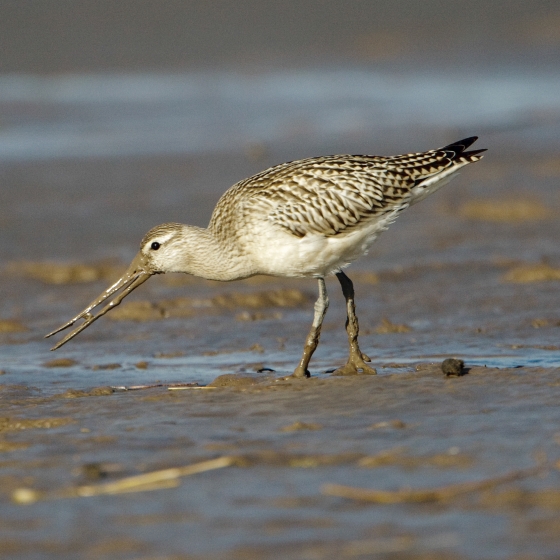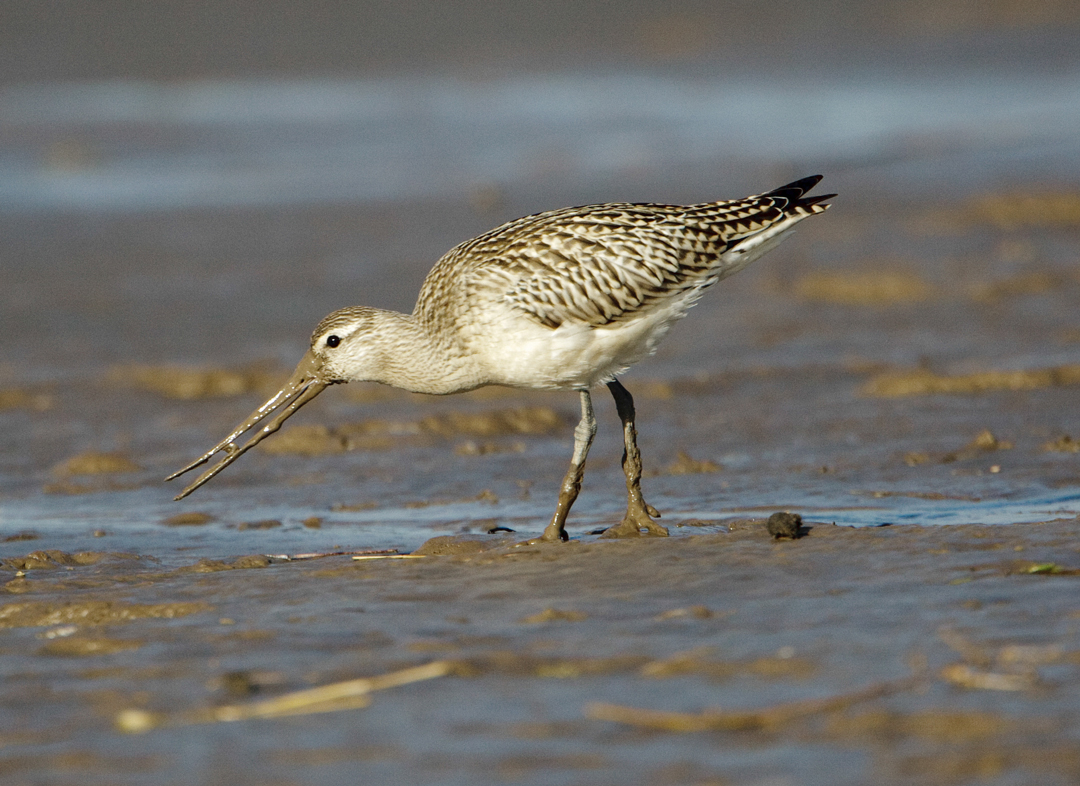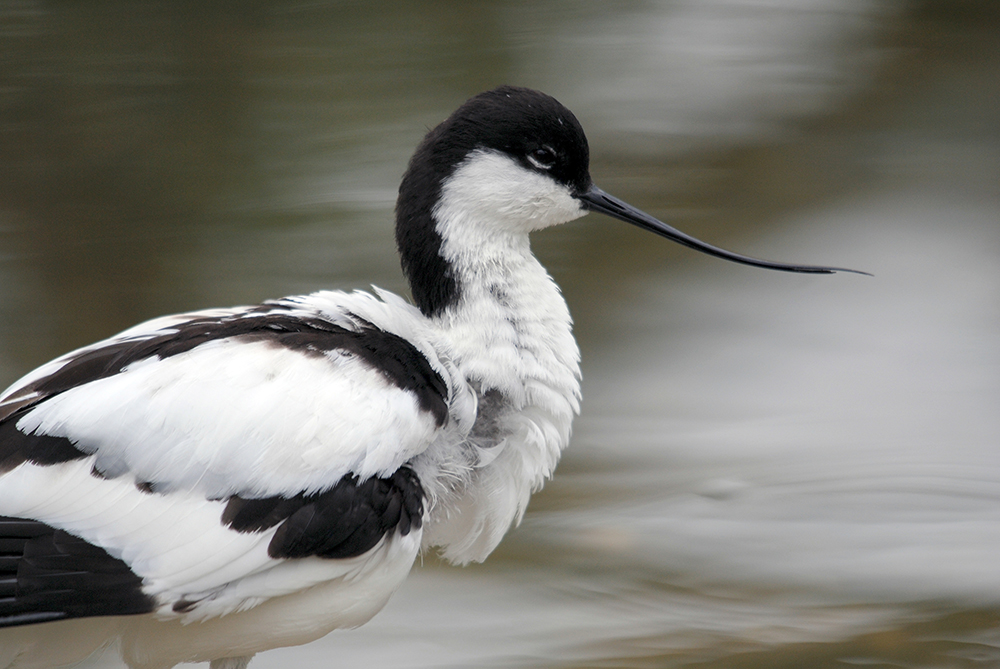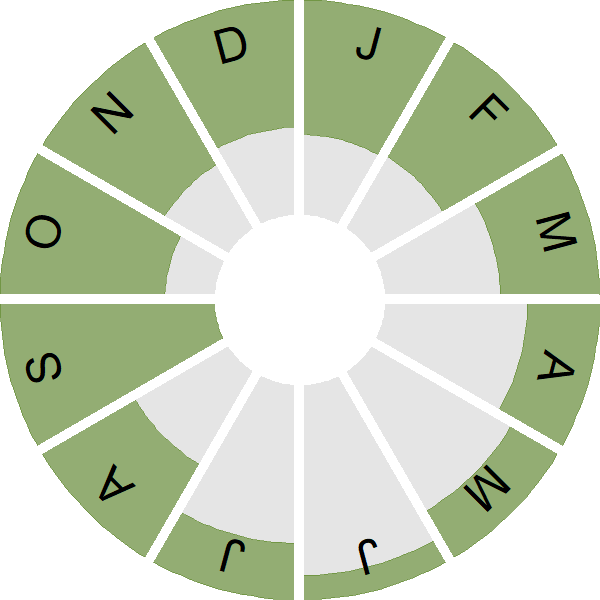Bar-tailed Godwit

Introduction
The Bar-tailed Godwit is a rather plain, but quite large wader, more or less confined to marine habitats around Britain's coasts.
Birds arrive from late summer and on into early winter from their arctic breeding grounds, favouring low-lying coasts with a muddy or sandy substrate. Their winter dress is pale greys and browns and they have a long, very slightly upturned bill, which is pink at the base.
The Wetland Bird Survey estimates a wintering population in Britain approaching 30,000 birds with two thirds spending the winter months on The Wash in eastern England. The tideline is the best place to observe Bar-tailed Godwits feeding, and at high tide they gather in tight flocks to roost.

Key Stats
Identification
ID Videos
This section features BTO training videos headlining this species, or featuring it as a potential confusion species.
Godwits
Songs and Calls
Alarm call:
Flight call:
Status and Trends
Conservation Status
Population Change
Bar-tailed Godwits from the Fennoscandian (lapponica) and central Siberian (taymyrensis) populations are winter visitors to the UK; by far the most important site for this species is The Wash estuary in eastern England, which is estimated to hold up to two-thirds of the wintering population Woodward et al. 2024]. Various other estuaries around the UK also suppport internationally important numbers in winter. [WeBS data show that numbers of Bar-tailed Godwits have declined since their peak in the early 2000s.
Distribution
Bar-tailed Godwits winter around the coast of Britain & Ireland, on suitable low-lying shores. They are largely absent from the north and west Scotland and elsewhere where there are sections of steep cliff coastline. Largest concentrations are associated with the major British and Irish estuaries, plus the low-lying shorelines of Northumberland, the Outer Hebrides and Orkney.
Occupied 10-km squares in UK
or view it on Bird Atlas Mapstore.
or view it on Bird Atlas Mapstore.
European Distribution Map
Distribution Change
Although there have been many winter-range gains in Britain since the 1980s, most are in marginal low-density areas such as Shetland, west Scotland, west Ireland, Wales and southwest England and may correspond to only small changes in the number of birds.
Change in occupied 10-km squares in the UK
or view it on Bird Atlas Mapstore.
Seasonality
Although mostly a winter visitor, some Bar-tailed Godwits remain in summer on larger estuaries and there is a pronounced peak in autumn migration.
Weekly pattern of occurrence
The graph shows when the species is present in the UK, with taller bars indicating a higher likelihood of encountering the species in appropriate regions and habitats.

Movement
Britain & Ireland movement
Foreign locations of birds ringed or recovered in Britain & Ireland
Dots show the foreign destinations of birds ringed in Britain & Ireland, and the origins of birds ringed overseas that were subsequently recaptured, resighted or found dead in Britain & Ireland. Dot colours indicate the time of year that the species was present at the location.
- Winter (Nov-Feb)
- Spring (Mar-Apr)
- Summer (May-Jul)
- Autumn (Aug-Oct)

European movements
EuroBirdPortal uses birdwatcher's records, such as those logged in BirdTrack to map the flows of birds as they arrive and depart Europe. See maps for this species here.
The Eurasian-African Migration Atlas shows movements of individual birds ringed or recovered in Europe. See maps for this species here.
Biology
Productivity and Nesting
Nesting timing
Egg measurements
Clutch Size
Fledging
Survival and Longevity
Survival is shown as the proportion of birds surviving from one year to the next and is derived from bird ringing data. It can also be used to estimate how long birds typically live.
View number ringed each year in the Online Ringing Report.
lifespan
Survival of adults
Biometrics
Wing length and body weights are from live birds (source).
Wing length
Body weight
Ring Size
Classification, names and codes
Classification and Codes
- Order: Charadriiformes
- Family: Scolopacidae
- Scientific name: Limosa lapponica
- Authority: Linnaeus, 1758
- BTO 2-letter code: BA
- BTO 5-letter code: BATGO
- Euring code number: 5340
Alternate species names
- Catalan: tètol cuabarrat
- Czech: brehouš rudý
- Danish: Lille Kobbersneppe
- Dutch: Rosse Grutto
- Estonian: vöötsaba-vigle
- Finnish: punakuiri
- French: Barge rousse
- Gaelic: Cearra-ghob
- German: Pfuhlschnepfe
- Hungarian: kis goda
- Icelandic: Lappajaðrakan
- Irish: Guilbneach Stríocearrach
- Italian: Pittima minore
- Latvian: sarkana puskuitala
- Lithuanian: laplandinis griciukas
- Norwegian: Lappspove
- Polish: szlamnik (zwyczajny)
- Portuguese: fuselo
- Slovak: brehár hrdzavý
- Slovenian: progastorepi kljunac
- Spanish: Aguja colipinta
- Swedish: myrspov
- Welsh: Rhostog Gynffonfraith
- English folkname(s): Yarwhelp, Barwit
Research
Causes of Change and Solutions
Causes of change
The exact drivers of decline are unclear; however, various threats have been identified that may impact the populations of this species that are seen here in winter. These include habitat fragmentation and loss, reduction of prey abundance, pollution, increased disturbance, climate change and hunting [Leyrer et al. 2014].
Publications (2)
Contrasting habitat use between and within Bar-tailed Godwit and Curlew wintering on the Wash, England
Author: Pell, R.J., Clark, J.A. & Robinson, R.A.
Published: 2024
Ongoing declines have been reported for many of our wader species, and there is an urgent need to both understand the reasons for these declines and assess the effectiveness of any associated conservation action.
04.01.24
Papers

Consequences of population change for local abundance and site occupancy of wintering waterbirds
Author: Méndez, V., Gill, J.A., Alves, J.A., Burton, N.H.K. & Davies, R.G.
Published: 2017
Protected sites for birds are typically designated based on the site’s importance for the species that use it. For example, sites may be selected as Special Protection Areas (under the European Union Directive on the Conservation of Wild Birds) if they support more than 1% of a given national or international population of a species or an assemblage of over 20,000 waterbirds or seabirds. However, through the impacts of changing climates, habitat loss and invasive species, the way species use sites may change. As populations increase, abundance at existing sites may go up or new sites may be colonized. Similarly, as populations decrease, abundance at occupied sites may go down, or some sites may be abandoned. Determining how bird populations are spread across protected sites, and how changes in populations may affect this, is essential to making sure that they remain protected in the future.
20.09.17
Papers


